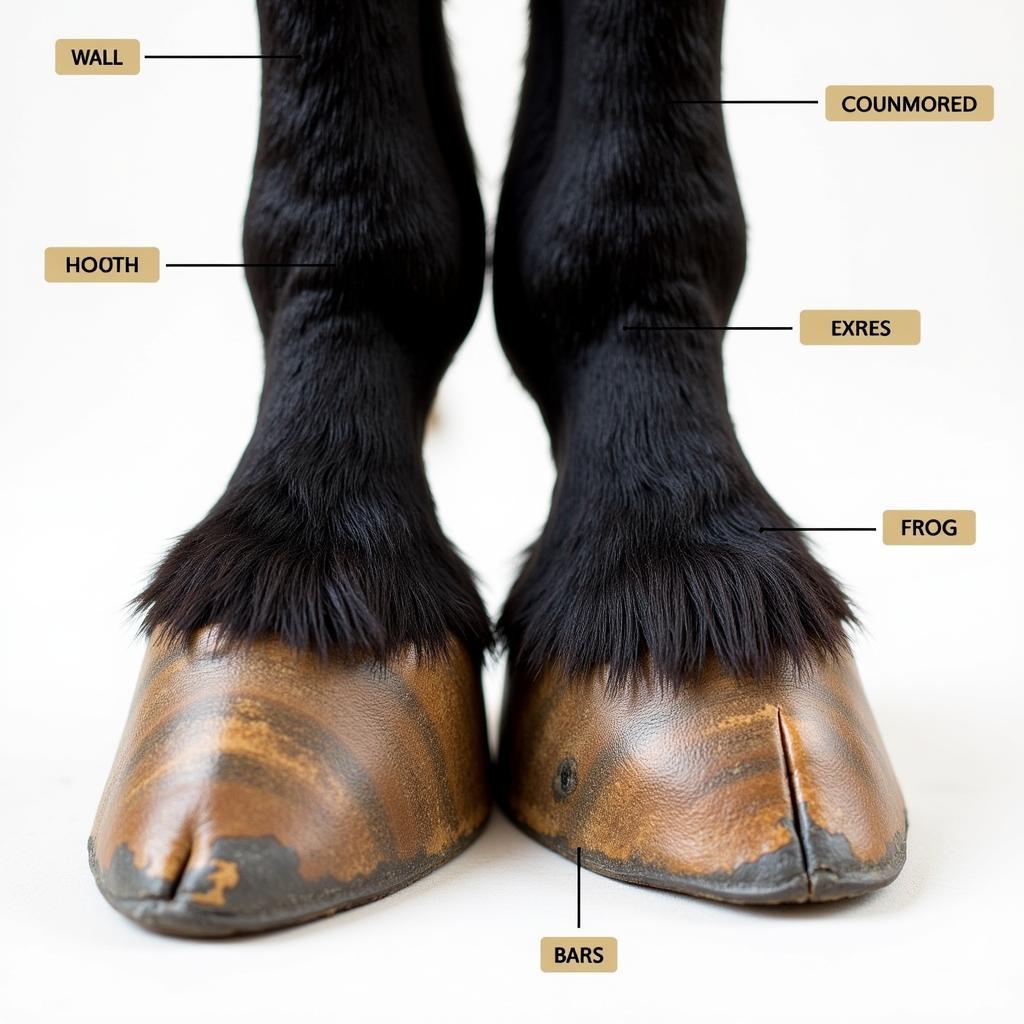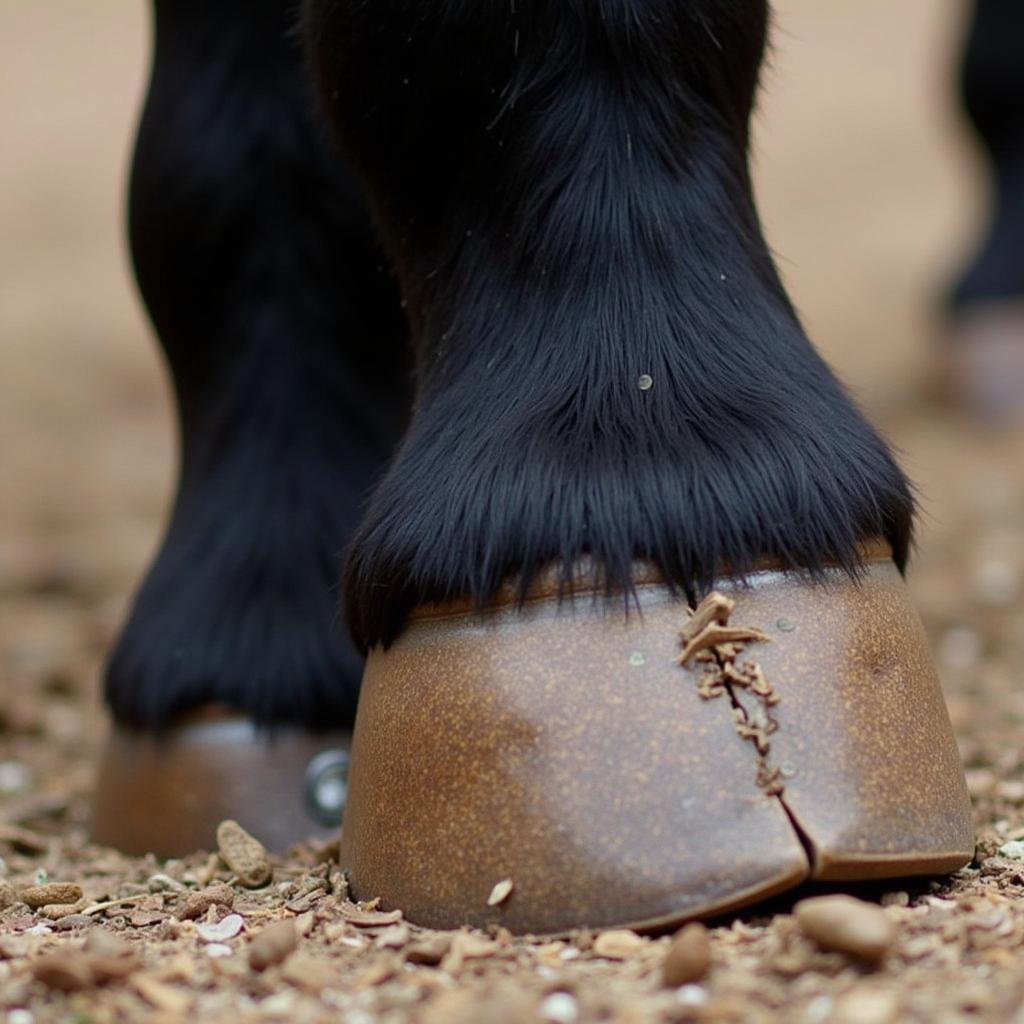Black Horse Hooves, often gleaming like polished ebony, are a fascinating subject for horse enthusiasts. While all hooves share a similar basic structure, there are certain nuances associated with black hooves that warrant closer examination. This article delves into the specifics of black horse hooves, covering everything from their composition and care to common misconceptions. We’ll explore what makes them unique and address some frequently asked questions. Let’s dive in and uncover the mysteries surrounding these dark and striking equine features. You might even be surprised by what you learn about caring for a horse with jet black hooves! Check out our guide on all black horse.
The Composition of Black Horse Hooves
Hooves, regardless of color, are primarily composed of keratin, the same protein that makes up human fingernails and hair. The pigment that gives black hooves their distinctive color is melanin. The concentration of melanin determines the shade of black, ranging from a deep, almost blue-black to a softer, charcoal gray. Interestingly, the outer layer of a black hoof, known as the wall, is often harder and denser than that of lighter-colored hooves. This added density can offer slightly more natural protection against wear and tear.
While the color difference might seem purely aesthetic, it can sometimes indicate subtle variations in hoof health and resilience. For instance, black hooves are sometimes perceived as being less prone to chipping and cracking compared to white hooves. However, this isn’t a universal rule, and proper hoof care is crucial regardless of color. Just like a jet black horse needs specialized grooming, so too do their hooves require particular attention.
 Anatomy of a Black Horse Hoof
Anatomy of a Black Horse Hoof
Caring for Black Horse Hooves: Tips and Tricks
Caring for black horse hooves requires the same diligent routine as for any other hoof color. Regular cleaning, trimming, and balancing are essential for maintaining healthy hooves. However, the dark pigmentation can sometimes make it slightly more challenging to detect certain issues, such as bruises or abscesses. Therefore, it’s crucial to pay extra attention during inspections.
- Cleaning: Use a hoof pick to remove dirt, debris, and packed-in mud. This prevents bacterial and fungal infections.
- Trimming: Regular trimming, typically every 6-8 weeks, is essential for maintaining proper hoof shape and balance.
- Moisturizing: While some believe black hooves are naturally more resilient, they can still dry out, especially in arid climates. Applying a hoof moisturizer or conditioner can help prevent cracking and maintain flexibility.
- Protection: If your horse works on hard surfaces or is prone to hoof problems, consider using hoof boots or protective pads.
A healthy hoof, whether black or white, will have a smooth, even surface, free from cracks and chips. Regular farrier visits are crucial for ensuring proper hoof care and addressing any potential issues early on. Thinking of dressing up for Halloween? Find the perfect Halloween costume for horse and rider.
Debunking the Myths Surrounding Black Horse Hooves
Several myths surround black horse hooves, often perpetuating misconceptions about their strength and resilience. One common myth is that black hooves are inherently stronger than white hooves. While they might exhibit slightly greater density in the outer wall, this doesn’t necessarily translate to superior overall strength. All hooves are susceptible to damage and disease. Another myth suggests that black hooves are less prone to thrush. This is also not entirely true. Thrush is a bacterial infection that can affect any hoof, regardless of color. Proper hygiene and management are key to preventing thrush in all horses.
“Proper nutrition plays a vital role in hoof health, irrespective of color,” says Dr. Emily Carter, DVM, a leading equine veterinarian. “A balanced diet rich in essential vitamins and minerals is crucial for supporting strong, healthy hoof growth in all horses, including those with black hooves.” Learn more about different hoof colors, like white hooves on horses.
 Healthy Black Horse Hooves
Healthy Black Horse Hooves
Conclusion: Embracing the Beauty of Black Horse Hooves
Black horse hooves are undoubtedly striking and add to the overall allure of these majestic animals. While some minor differences might exist compared to other hoof colors, the fundamental principles of hoof care remain the same. Regular cleaning, trimming, and a balanced diet are essential for maintaining healthy black horse hooves. By understanding their unique characteristics and debunking common myths, we can better appreciate the beauty and resilience of these dark, gleaming hooves. For a visual representation, explore our page on the horse head with horseshoe.
FAQ:
- Are black hooves stronger than white hooves? Not necessarily. While the outer wall might be denser, overall strength depends on various factors, including nutrition and care.
- Do black hooves require special care? The basic principles of hoof care apply to all hooves. However, the dark color can make some issues harder to detect, requiring extra vigilance during inspections.
- What causes the black color in hooves? Melanin, the same pigment that colors human hair and skin, gives black hooves their distinctive color.
- Are black hooves more resistant to thrush? No. Thrush can affect any hoof color. Proper hygiene is essential for prevention.
- How often should black hooves be trimmed? Every 6-8 weeks, similar to other hoof colors.
“Regular hoof care is not just about aesthetics; it’s about the horse’s overall well-being,” adds Dr. Carter. “Early detection and treatment of hoof problems can prevent more serious issues down the road.”
Another common question we get is: “Do different breeds have different hoof colors?” While some breeds are more likely to have black hooves than others, hoof color variation exists within most breeds.
For further reading, consider looking into the genetic factors influencing hoof color in horses.
Need assistance with your horse’s hoof care? Contact us at Phone: 0772127271, Email: [email protected] or visit us at QGM2+WX2, Vị Trung, Vị Thuỷ, Hậu Giang, Việt Nam. Our customer service team is available 24/7.